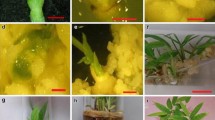Summary
Two methods of in vitro culture were employed to regenerate papaya plants. One involved regeneration of plants from callus and the other, production of multiple plants from single shoot-tip explants. Callus was induced from stem sections of papaya seedlings in a medium containing 1 mg per 1 NAA and 0.1 mg per 1 kinetin. The callus regenerated shoots and/or embryoids when transferred to a medium of lower auxin, 0 to 0.05 mg per 1 IAA, and higher cytokinin, 1 to 2 mg per 1 kinetin Multiple shoots were produced when the excised shoot-tip explants were cultured in a medium supplemented with 0.05 mg per 1 IAA and either 5 mg per 1 kinetin or 0.5 to 1.0 mg per 1 benzyladenine. Root formation of the shoots or embryoids that derived from callus or shoot tips occurred in a medium containing 5 mg per 1 IAA and in a light intensity of 3000 to 4000 Ix. The rooted plants could be established in soil and under standard greenhouse conditions after they had been acclimated by initially growing them in moist vermiculite contained in polyethylene-covered pots.
Similar content being viewed by others
References
Storey, W. B. 1938. The primary flower type of papaya and the fruit types that develop from them. Proc. Am. Soc. Hortic. Sci. 35: 80–82.
Clare, M. V., and H. A. Collin. 1974. The production of plantlets from tissue culture of Brussels sprout (Bassica L. var. gemmifera D.C.). Ann. Bot. (London) 38: 1067–1076.
Murashige, T. 1974. Plant propagation through tissue culture. Annu. Rev. Plant Physiol. 25: 135–166.
Pillai, S. K., and A. C. Hildebrandt. 1969. Induced differentiation of geranium plants from undifferentiated callus in vitro. Am. J. Bot. 56: 52–58.
Saunders, J. W., and E. T. Bingham. 1972. Production of alfalfa plants from callus tissue. Crop Sci. 12: 804–808.
Williams, L., and H. A. Collin. 1976. Embryogenesis and plantlet formation in tissue culture of celery. Ann. Bot. (London) 40: 325–332.
Steward, F. C. 1969.Plant Physiology. Academic Press, New York and London, pp. 259–262, 279–281.
Hasegawa, P. M., T. Murashige, and F. H. Takatori. 1973. Propagation of asparagus through shoot apex culture. II. Light and temperature requirements, transplantability of plant, and cytohistological characteristics. J. Amer. Soc. Hortic. Sci. 98: 143–148.
Murashige, T., M. N. Shabde, P. M. Hasegawa, H. H. Takatori, and J. B. Jones. 1972. Propagation of asparagus through shoot apex culture. I. Nutrient medium for formation of plantlets. J. Amer. Soc. Hortic. Sci. 97: 158–161.
Murashige, T. 1974. Plant cell and organ culture methods in the establishment of pathogen-free stock. 2nd Annual A. W. Dimock Lecture, Cornell University, Ithaca, New York.
Murashige, T., and F. Skoog. 1962. A revised medium for rapid growth and tobacco tissue culture. Physiol. Plant. 15: 473–479.
Jensen, W. A. 1962.Botanical Histochemistry. Freeman, San Francisco.
Author information
Authors and Affiliations
Additional information
This research was supported by the National Science Council, Republic of China.
Rights and permissions
About this article
Cite this article
Yie, ST., Liaw, S.I. Plant regeneration from shoot tips and callus of papaya. In Vitro 13, 564–568 (1977). https://doi.org/10.1007/BF02627852
Issue Date:
DOI: https://doi.org/10.1007/BF02627852




